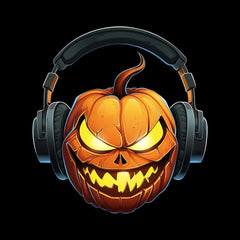Album cover art is one of the most captivating and influential forms of visual culture in the last century. From the birth of vinyl to the digital era, the art on record sleeves has often been as iconic and memorable as the music itself. For collectors and music enthusiasts, album covers tell a visual story that enhances the experience of listening, transcending the confines of audio to become lasting works of art. Beyond their aesthetic value, many classic album covers have fascinating backstories and high levels of collectability, making them cultural treasures.
The Art and Innovation of Album Covers
Album covers first began to evolve into a canvas for creative expression in the mid-20th century. Before that, records came in plain, often brown, wrappers, designed for practicality rather than flair. The introduction of the 33⅓ rpm long-playing record (LP) in 1948 by Columbia Records not only revolutionized how music was consumed but also how it was presented. These larger LPs provided a platform for album art, allowing artists and designers to create iconic visual companions to the music.
One of the earliest examples of cover art influencing record sales was Alex Steinweiss’ work in the 1940s, where he designed vibrant, imaginative covers for Columbia’s releases. His designs were so compelling that sales skyrocketed, proving the marketability of visual branding for music. This set the stage for the golden age of album covers.
Iconic Album Covers and Their Stories
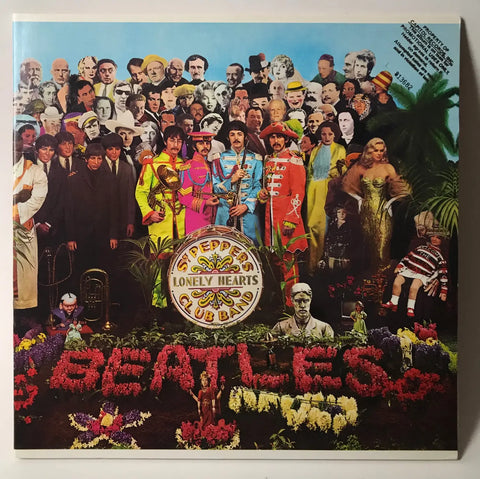
The Beatles, Sgt. Pepper’s Lonely Hearts Club Band (1967)
Arguably one of the most famous album covers in music history, Sgt. Pepper’s not only redefined The Beatles’ sound but also their visual identity. Designed by Peter Blake and Jann Haworth, this cover featured a collage of cardboard cutouts of famous historical figures, from Marilyn Monroe to Albert Einstein, surrounding the band members dressed in colorful military-style uniforms. The cover broke new ground in several ways—it was one of the first to be as conceptual and artistic as the music itself.
The Beatles even invited fans to take a deeper look at the album’s visuals, which were filled with references and hidden messages. For instance, the inclusion of a floral arrangement spelling out “Beatles” or the presence of a small doll wearing a Rolling Stones sweater led to various fan theories. Because of its cultural significance, original pressings of Sgt. Pepper’s have become highly collectible, with first editions fetching thousands of dollars.
Pink Floyd, The Dark Side of the Moon (1973)
Designed by Storm Thorgerson and Aubrey Powell of the design group Hipgnosis, the cover of The Dark Side of the Moon is simple yet instantly recognizable. Featuring a prism dispersing light into a rainbow, the image was meant to reflect the band's lighting design for live shows and the album’s conceptual themes of conflict, greed, and mental health. This minimalist design has since become a symbol for Pink Floyd and progressive rock in general.
What makes this cover so collectible is its continued cultural relevance. Original UK pressings with the blue triangle on the label, in mint condition, are highly sought after by collectors and can sell for well over $1,000. The clean, iconic design has ensured that it remains one of the most enduring images in rock history.
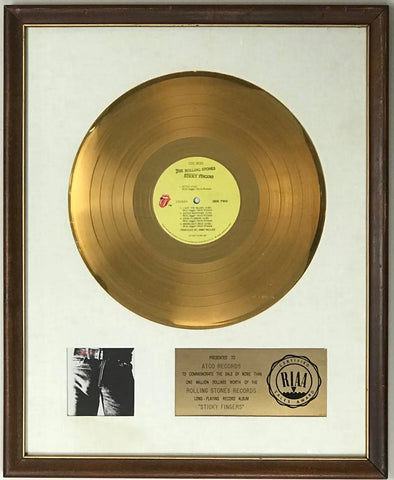
The Rolling Stones, Sticky Fingers (1971)
Sticky Fingers was notable not only for its music but also for its innovative cover art. Designed by Andy Warhol, the original LP cover featured a close-up of a man’s crotch in tight jeans, complete with a working zipper. When unzipped, the cover revealed a pair of underwear underneath. This playful, provocative design made waves upon release and was reflective of the Stones' rebellious image.
For collectors, Sticky Fingers presents a unique opportunity, as early versions with the working zipper intact are particularly desirable. Over time, many copies were damaged by the zipper pressing into the vinyl during storage, making pristine versions rare. Those still in good condition can sell for several hundred dollars or more, especially with original inserts.
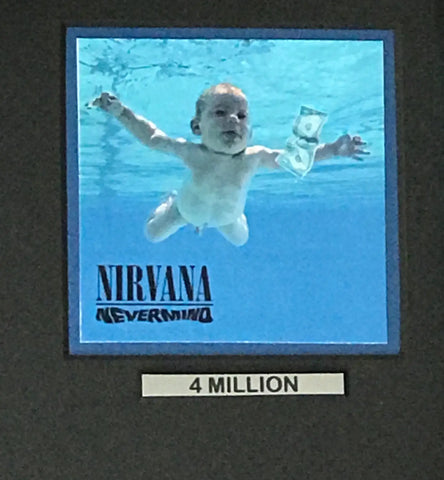
Nirvana, Nevermind (1991)
Nirvana’s Nevermind is an album that changed the trajectory of music in the early 1990s, helping to popularize the grunge movement. The cover, which shows a baby swimming towards a dollar bill on a fishhook, was provocative and instantly recognizable. It was shot by photographer Kirk Weddle, and the image was meant to reflect the themes of innocence, consumerism, and the pressures of modern life.
Interestingly, the baby on the cover—Spencer Elden—later sued the band for the use of his image, though the lawsuit was eventually dismissed. Despite the controversy, the Nevermind cover remains iconic, and original pressings of the album, especially on vinyl, have become collectible, often fetching several hundred dollars depending on condition and region of release.
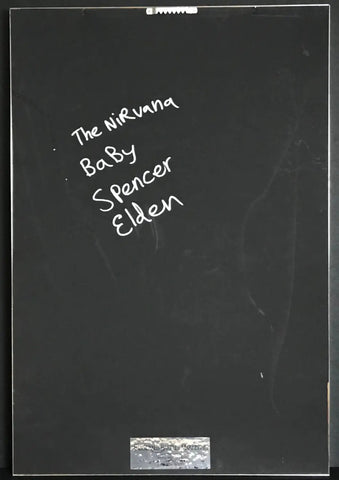
Despite having sued the band, Elden has signed the backs of record awards for Nevermind, like the one shown above.
The Role of Album Covers in Collectability
While the music itself is the primary draw for collectors, album covers play a crucial role in determining a record’s value. Several factors influence the collectability of an album cover, including the rarity of the pressing, the condition of the cover, the presence of unique features (like inserts, posters, or gatefold designs), and, of course, the cultural significance of the cover art.
Rare Variants and Special Editions
Some of the most valuable album covers are tied to rare variants or special editions. For example, The Beatles' White Album (1968) is famously plain, featuring nothing more than the band's name embossed on a white background. However, early pressings of the album were individually numbered, and these copies are highly collectible. First pressings with low serial numbers (like 0000001 to 5, which were of course issued to the Beatles themselves) are considered to be some of the most valuable records in the world.
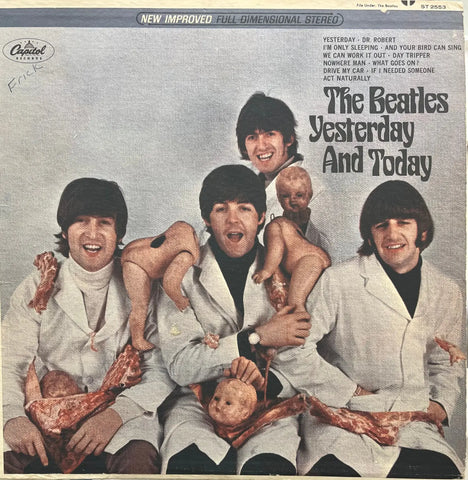
Similarly, banned or censored covers can drive up the collectability of an album. The original cover of The Beatles’ Yesterday and Today (1966), known as the “butcher cover,” featured the band in butcher smocks surrounded by dismembered dolls and raw meat. The image was quickly pulled after negative reactions, but copies of the original cover that survived are now worth thousands.
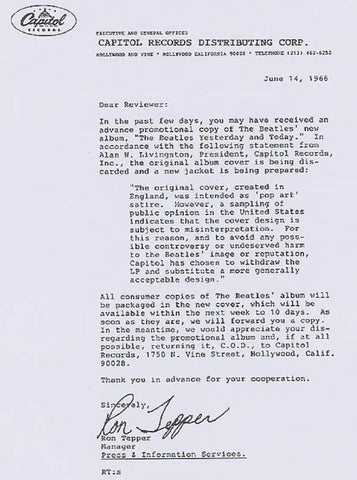
The infamous Beatles "butcher cover" recall letter from Capitol Records
Condition is Key
Like all collectibles, condition plays a significant role in determining value. Mint-condition records with undamaged sleeves, original shrink wrap, or factory stickers are more valuable than those showing wear and tear. Even slight blemishes—like ring wear, where the shape of the vinyl leaves a mark on the cover—can diminish a record’s value.
Signed Covers and Artist Involvement
Albums signed by the musicians or the artists who created the cover can also fetch a premium. For example, an album cover signed by Andy Warhol, who designed several famous covers including The Velvet Underground & Nico (1967), can increase the value of the record exponentially. As Warhol’s fame grew, his connection to these iconic covers added an entirely new layer of significance to these albums.
Peter Blake-signed copies of the Beatles Sgt. Pepper album cover or album art slicks also draw premium prices, but not nearly as high as those in the Warhol example.
Album Art in the Digital Era
With the rise of digital music streaming, the importance of physical album covers has shifted, but it hasn’t disappeared. Vinyl has made a significant comeback, and with it, the desire for beautiful, large-format cover art. Collectors still value the tactile experience of holding a record, examining its cover, and even smelling the ink and vinyl.
In some cases, the rarity and beauty of album covers have even outlasted the relevance of the music itself, making these visual pieces timeless collectors’ items. Modern artists continue to innovate in the field of album art, knowing that in a crowded digital landscape, a powerful visual can still make an indelible mark.
Album covers are more than just packaging—they are cultural artifacts that tell the story of the music and the era in which they were created. Whether through stunning artwork, provocative imagery, or unique design elements, iconic album covers have become collectible items in their own right. For music lovers and art collectors alike, the stories behind these covers enhance their value, making them timeless pieces that transcend the music they contain.
Interested in genuine, properly authenticated signed music memorabilia? Check out our selection here. How about genuine RIAA Gold and Platinum and other record awards? Check out our selection here. We typically have hundreds in stock.
Want more content like this? If you're not a subscriber already, sign up for our free MusicGoldmine newsletter which comes out every two weeks. Go here to sign up plus get a code for 15% off your first purchase.
Be the envy of all your friends! Get MusicGoldmine.com Music History in your Facebook feed each day. Just follow us on Facebook here.
All photos © MusicGoldmine

